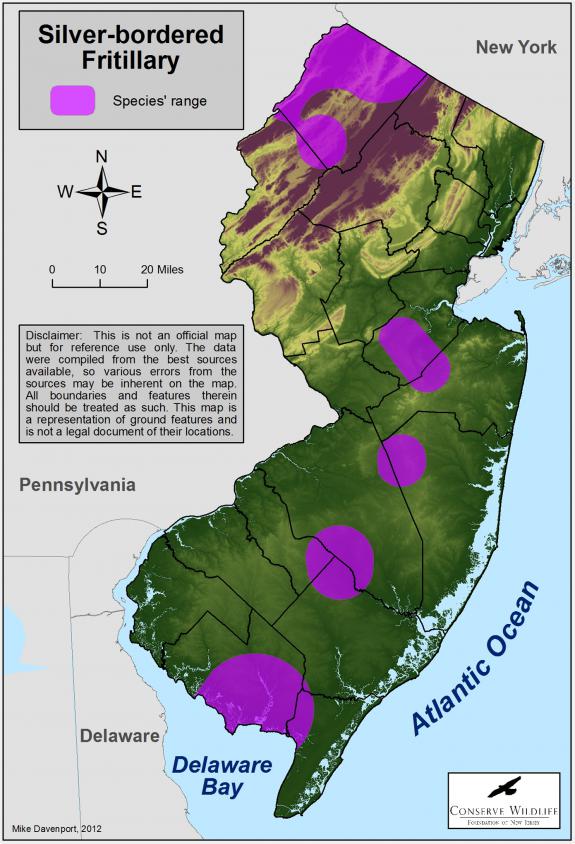Bolaria selene myrina
Type: invertebrate
Status: threatened
Species Guide
Silver-bordered fritillary
Bolaria selene myrina
Species Type: invertebrate
Conservation Status: threatened
Identification
The wings of the silvered-bordered fritillary are orange with black markings. This species reaches sizes of 1.6 in. to 2.75 in. (39-45 mm). It can be distinguished from other closely related species by the presence of silver spots on the underside of the hindwing. Another very useful diagnostic characteristic is the black margin that encloses several small orange spots on the upper surface of the forewing.

Distribution & Habitat
New Jersey is the southeastern range limit for this butterfly. It ranges west to Oregon and north throughout most Canadian provinces.
The silver-bordered fritillary inhabits moist open areas, like bogs, sedge meadows, wet grasslands, and other wet areas.
Diet
Caterpillars feed exclusively on the leaves of violets (Viola spp.). Adults feed on nectar from the flowers of red clover (Trifolium pretense), aldafla (Medicago sativa), common milkweed (Asclepias syriaca), butterfly weed (Asclepias tuberose), and purple coneflower (Echinacea purpurea).
Life Cycle
The silver-bordered fritillary is active from late May to early September in New Jersey. Its peak flight period is around late June and August. They are known to have two broods per year. Caterpillars (larvae) are a dark grayish black with many black spots and a lateral orange line and orange spines with black tips. Adult females lay eggs on or near host plants (violets). Once hatched, the larvae move to the host plant to feed. They overwinter as larvae in New Jersey.
Current Threats, Status, and Conservation
Like other wetland dependent species in New Jersey, the silver-bordered fritillary has been negatively affected from loss of habitat, especially the filling of wetlands. The use of insecticides to control mosquitoes and gypsy moths has also contributed to the decline of this species. The silver-bordered fritillary is widespread and abundant across much of its range. Because New Jersey is located along the southeastern limit of this species range, silver-bordered fritillaries are less common in New Jersey than in many northern states and Canadian provinces. Surveys for this species could help identify and protect suitable wetland habitat that would benefit this rare butterfly.
In 2015, the New Jersey Endangered and Nongame Advisory Committee recommended changing this species’ status from Threatened to Endangered within the state, but no formal rule proposal has been filed to date.
References
Beans, B.E. and Niles, L. 2003. Endangered and Threatened Wildlife of New Jersey.
Edited and updated in 2010 by Ben Wurst and in 2016 by Mike Davenport.
Scientific Classification
- Kingdom: Animalia
- Phylum: Arthropoda
- Class: Insecta
- Order: Lepidoptera
- Family: Nymphalidae
- Genus: Boloria
- Species: B. selene